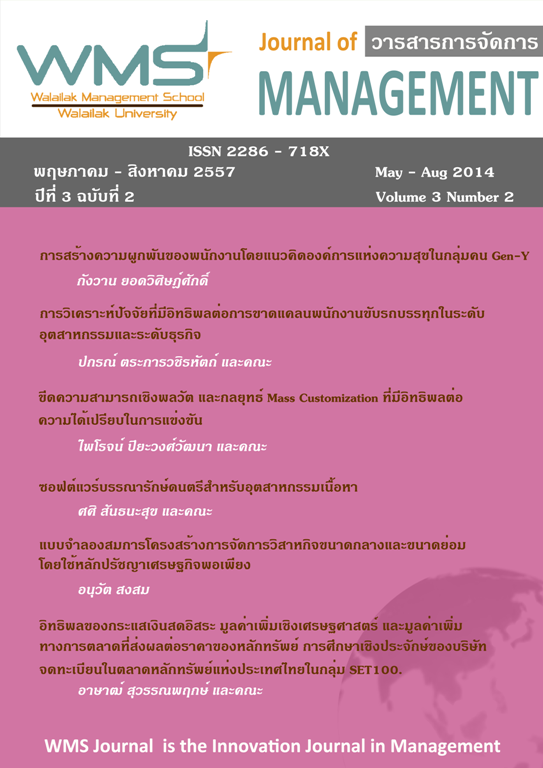Building up Employee Engagement through Happy Workplace Concept
Main Article Content
Abstract
Objective: This article aimed at identifying means to raise employee engagement, especially in Gen-Y employees, for management in both private and public sectors. Since Gen-Y employee’s behavior is different from the prior generations, the once-successful methods in raising engagement may not be applicable to this group of employees. Moreover, the conceptual framework of the relationship between happy workplace and employee engagement will also be recommended.
Methodology: The review of literatures in 3 major areas, which are employee engagement, Gen-Y employees and happy workplace.
Result: Happy workplace concept, which contains 8 happy criteria, has been agreed upon amongst academia and practitioners to be a technique in building up employee engagement.Article Details
References
ขจรศักดิ์ เพ็ชรรัตน์. 2554. การสร้างความสุขในที่ทำงาน. (ออนไลน์). http://www2.tsu.ac.th/health_sci/main/ files_sec3/3148074848201248%E0%B8%81%E0%B8%B2%E0%B8%A3%E0%B8%AA%E0%B8%A3%E0%B9%89%E0%B8%B2%E0%B8%87%E0%B8%84%E0%B8%A7%E0%B8%B2%E0%B8%A1%E0%B8%AA%E0%B8%B8%E0%B8%82%E0%B9%83%E0%B8%99%E0%B8%97%E0%B8%B5%E0%B9%88%E0%B8%97%E0%B8%B3%E0%B8%87%E0%B8%B2%E0%B8%99%20(Happy%20Workplace)%20(2554).pdf
ธรรมรักษา. 2542. วิถีแห่งความสุข. กรุงเทพมหานคร: สำนักพิมพ์สติ.
นงลักษณ์ ไชยเสโน. 2553. ความผูกพันขององค์กรต่อพนักงาน. (ออนไลน์). http://www.pmat.or.th/index.php/media-center/download/ viewdownload/6-free-seminar/4-employee-engagement
ราชบัณฑิตยสถาน. 2546. พจนานุกรมฉบับราชบัณฑิตยสถาน พ.ศ. 2542. กรุงเทพฯ: นานมีบุ๊คพับลิเคชั่นส์ จำกัด.
รุ่งโรจน์ อรรถานิทธ์. 2554. Employee Engagement: การสร้างความผูกพันของพนักงานในองค์กร. กรุงเทพฯ: เอช อาร์ เซ็นเตอร์.
วรัญญา ศรีเสวก. เหตุผลที่ไม่มีเหตุผลของคน Gen Y. (ออนไลน์). http://www.wiseknow.com/blog/2009/08/31/3289/#axzz2r3k5DDHu
เสาวนีย์ พิสิฐานุสรณ์. 2010. Why Generation: Generation Y: Gen Y. (ออนไลน์). http://www.sara-dd.com/index.php?option=com_ content&view=article&id=235:why-generation-generation-y-gen-y-&catid=25:the-project&Itemid=72
สิรินภา กิจเกื้อกูล. หลักปรัชญาเศรษฐกิจพอเพียง. (ออนไลน์) http://office.nu.ac.th/edu_teach/ASS/Download/vchk-%E0%B8%AB% E0%B8%A5%E0%B8%B1%E0%B8%81%E0%B8%9B%E0%B8%A3%E0%B8%B1%E0%B8%8A%E0%B8%8D%E0%B8%B2%E0%B9%80%E0%B8%A8%E0%B8%A3%E0%B8%A9%E0%B8%90%E0%B8%81%E0%B8%B4%E0%B8%88%E0%B8%9
E%E0%B8%AD%E0%B9%80%E0%B8%9E%E0%B8%B5%E0%B8%A2%E0%B8%87-%E0%B8%AA%E0%B8%B4%E0%B8%A3%E 0%B8%B4%E0%B8%99%E0%B8%A0%E0%B8%B2.pdf
สำนักงานกองทุนสนับสนุนการสร้างเสริมสุขภาพ. Happy 8 หรือความสุข 8 ประการ. (ออนไลน์). http://www.thaihealth.or.th
Bhatnagar, J. 2007. Talent management strategy of employee engagement in Indian ITES employees: key to retention. Employee Relations. Vol 29. Issue 6. pp 640 – 663.
Hewitt Associates LLC. 2005. Employee engagement. (Online). https://ceplb03.hewitt.com/bestemployers/turkey/pages/emp_ eng.htm
Kotler, P. and Lee, N. 2005. Corporate Social Responsibility: Doing the Most Good for Your Company and Your Cause. NJ: John Wiley & Sons.
Manion, J. 2003. Joy at work: Creating a positive workplace. Journal of Nursing Administration. Vol 33. No 12. pp 652-655.
National Master. 2003. Thailand Population Pyramid for 2010 and 2011. (Online). http://www.nationmaster.com/country/th/Age_ distribution
Robbins, S.P. and Judge, T.A. 2010. Organizational Behavior. 14th ed. NJ: Pearson Education.
Supamas. 2011. ความสุขในที่ทำงานจะสร้างให้เกิดได้อย่างไร ตอนที่ 2. (Online). http://www.bangkokvoice.com/2011/02/09/happy-workplace-2/
Turnock, B. 2009. Public Health: What It Is and How It Works. 4th ed. MA: Jones and Bartlett Publishers.
Vincent-Hoper, S., Muser, C. and Janneck, M. 2012. Transformational leadership, work engagement and occupational success. Career Development International. Vol 27. No 7. pp 663-682.


